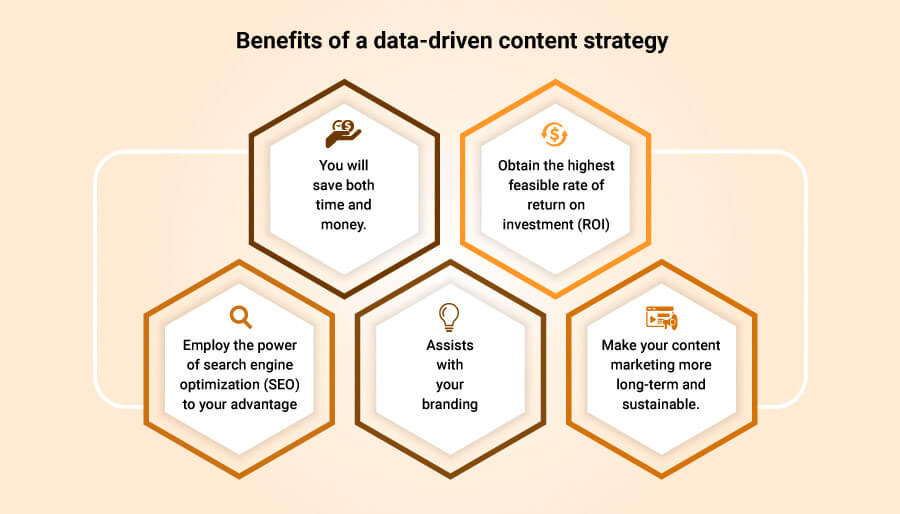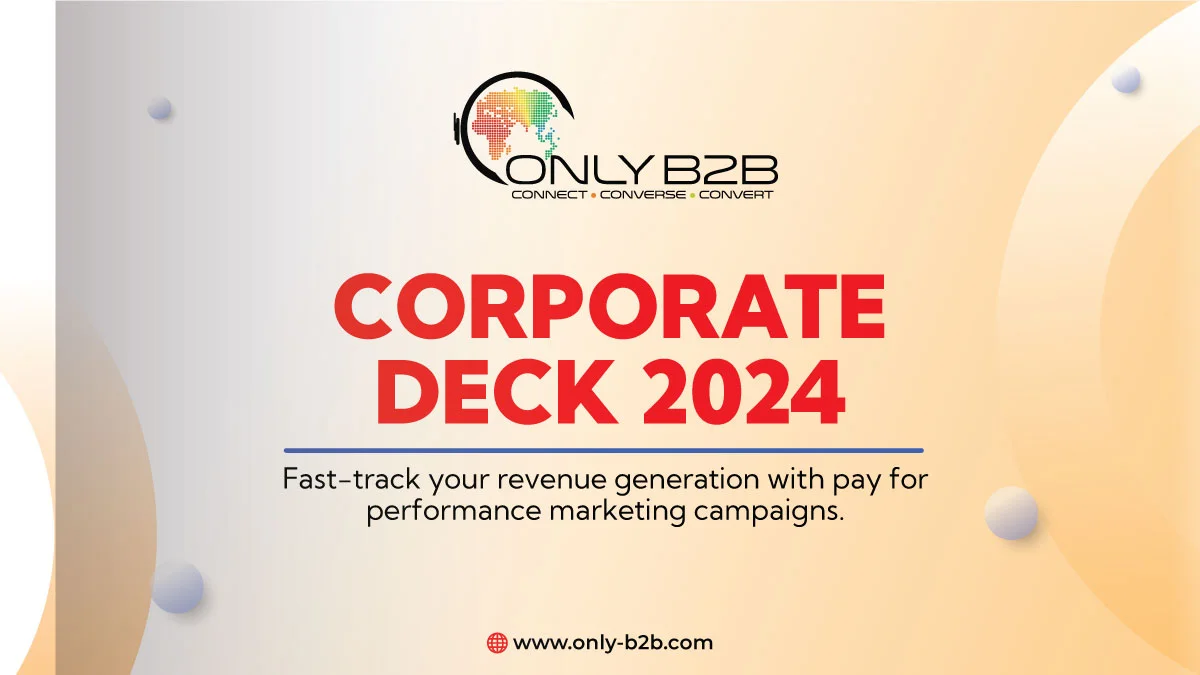
Data is the backbone of every effective content strategy.
There’s a reason why the concept “data-driven content marketing” has become so popular recently. You can’t count on speculations and intuitive feeling in today’s dynamic environment – that’s a certain way to burn up your money and eventually end up nowhere.
Data should be the gasoline that powers your marketing machine, whether you’re a little firm or a giant organization. You can design a smart content program that will help your organization produce more B2B leads and conversions by utilizing statistics to influence every preference.
This article will walk you through steps for constructing a data-driven content strategy. You’ll also discover what data-driven means, why it’s important, and how to effectively adopt it at your own organization.
What does it mean to have a data-driven content strategy?
Table of Contents
- 1 What does it mean to have a data-driven content strategy?
- 2 What are the benefits of a data-driven content strategy?
- 3 What is the best way to build a data-driven content strategy?
- 3.1 1. Create a framework based on data.
- 3.2 2. Get to know your target market and audience.
- 3.3 3. Organize your content according to customer buyer personas.
- 3.4 4. Regularly optimize your content
- 3.5 5. Existing content can be recycled to be shared on new platforms.
- 3.6 6. To measure success metrics, use data analytics tools.
- 3.7 Share this:
A data-driven content strategy is a method of creating and implementing content that strongly depends on advanced data analytics. Rather than instinct or predictions, all content strategies are based on facts obtained through analysis and statistics.
A data-driven strategy aims to improve content delivery while also ensuring positive audience reaction and also help in content syndication.
To do so, you must first comprehend:
- Your area of expertise
- Your competitor
- Your audience’s primary choices
- The platforms you publish your content on
You must also use data at various stage of the content creation process, including pre-production, publication, and post-production. Data will assist you in developing a thoughtfully created content strategy, writing optimized articles that attract to your target audience, and improving them significantly once they’ve been published.
For research, analysis, and data collecting in data-driven content marketing, it’s ideal to use content analytics solutions. Data churning manually takes time and sometimes leads in erroneous findings.
What are the benefits of a data-driven content strategy?
According to Google, “Nearly two-thirds of prominent marketers feel that data-driven judgments are preferable than gut instinct ones,” and according to Forbes, “64% of surveyed executives strongly believe’ that data-driven marketing is essential to succeed in a super competitive global marketplace,”
But how does data-driven marketing benefit so well, and how can it assist your business? There are several factors for this.

- You will save both time and money.
- Obtain the highest feasible rate of return on investment (ROI)
- Employ the power of search engine optimization (SEO) to your advantage
- Assists with your branding
- Make your content marketing more long-term and sustainable.
Must Read: A Brief Guide to Generate Leads Using ABM Content Syndication
What is the best way to build a data-driven content strategy?
What data should you gather, how should you acquire it, and how should you utilize your study to enhance outcomes?
Let’s go through nine data-driven, battle-tested techniques for taking your content marketing to the next level, starting with building a foundation for all your hard work.

1. Create a framework based on data.
Here’s a step-by-step guide to incorporating statistics into your content marketing strategy. You may use this framework as-is, expand it, or integrate it into your existing approach.
- Analyze your audience and define your content’s aims and objectives.
- Examine your market and competition.
- Perform a keyword search
- Develop content based on what you’ve learned.
- Create a content delivery system.
- Analyze and improve data
Let’s speak about a few tried-and-true ways for improving your content marketing now that you know how to include a data-driven approach into your efforts.
2. Get to know your target market and audience.
Your content marketing is destined to fail from the beginning if you don’t know who you’re developing content for.
Who are you attempting to contact? What are their desires and needs, what drives them, and what keeps them up at night? Where can you locate your target audience, both online and offline, so you can interact with them genuinely?
Before you write a single line, you must know the solutions to these concerns. If you overlook this phase, it’s like shooting arrows without spotting the target: you could strike something, but it’s doubtful and unexpected.
Here’s a rundown of information about your target audience that you should be aware of:
- Demographic characteristics
- Employment and revenue
- Buying habits
- Your target audience’s pain points
- Emotional triggers that entice people to buy your product
- Content Preferences
- Main platforms where your target audience looks for material
What’s the best way to find all of this information? There are a few simple methods for getting started:
- Google Search Console is a useful tool.
- Conduct a customer poll.
- Include data gathering forms on your website
- Look for internet communities where your target audience congregates.
- Inquire with your sales team.
- Examine your competitors.
Knowing your target market will aid in the creation of buyer personas, which are fictitious versions of your ideal customer. They’re also required for personalizing your content marketing.
3. Organize your content according to customer buyer personas.
We all know that one-size-fits-all clothing does not suit everyone properly. The same is true in terms of content.
The buyer personas will assist you in answering this issue and preparing correct, tailored messaging. Even if they’re both in your customer base, a post for a middle-aged working mom should look a little different from one for a bright, fresh-out-of-college, ambitious professional woman.
There’s one additional thing you must know prior to actually mapping your content :where your reader is most likely in the customer journey.
Are they still learning about your genre and scanning educational content, or are they on the verge of purchasing and reading your guides?
You must adjust your content to one of the three client journey stages:
- Understanding
- Evaluation
- Resolution
4. Regularly optimize your content
One of the most effective approaches to increase content marketing outcomes is to optimize content.
Without post-publication optimization, no SEO campaign would be ready. First and foremost, rather than starting from scratch, it is preferable to work with what already works. Secondly, Google’s algorithms are continually evolving, so even if an item is ranked number 10 today, it may be ranked lower tomorrow as a result of a change.
And if you’re meticulous about SEO, your material will constantly be current with your product and market trends. You don’t want to provide your readers outdated information, do you?
Examine Google Search Console and Google Analytics on a regular basis to keep track of your content’s progress. Google Search Console will assist you in tracking your SEO, while Google Analytics will provide data on your audience, platforms, and conversions.
Always pick sites that meet the following criteria while looking for the finest optimization possibilities:
- Rank the highest in Google for search queries you want to target
- Have the maximum number of impressions possible
Material repurposing allows you to get the most out of your current content. It’s the heart of the “more outcomes with less resources” concept that should be followed by every data-driven content strategy.
You may benefit from content recycling in the following ways:
- It improves your search engine optimization.
- It allows you to reach out to a larger audience.
- It aids in increasing the amount of visitors to your website.
- It improves the image of your company.
Consider how many birds you can kill with a single stone. To begin recycling your content based on statistics, you must first determine which channels your audience uses and what sorts of content they enjoy.
6. To measure success metrics, use data analytics tools.
The core goal of content marketing is to assist business and marketing objectives, not to create content. However, there are several indicators that must be tracked over time in order to evaluate if you’re genuinely successful.
We may divide content marketing success measures into four categories:
- User behavior
- Engagement
- Success in SEO
- Revenue
Is your content profitable? This is the be-all and end-all of all marketing efforts. Did you generate leads, convert those leads, and how did those conversions affect your ROI? You may track leads and conversions by using Google Analytics or other specific tools to set up and track targets.
Because not every bit of content converts to a sale, various analytics should be emphasized for different bits. You should have no trouble doing so if you’ve clearly identified your content marketing objectives and the stages of the client journey that each item relates to.
- Prioritize Metrics related to user behavior, popularity, and SEO performance while creating material for the initial stage.
- You should concentrate on engagement metrics for material in the evaluation stage.
- It’s important to concentrate on revenue for content at the purchasing stage.
Must Read: All You Need To Know About Content Syndication
Conclusion
To win in today’s competitive industry, data-driven content marketing is the only way to go.
You’ll have a better chance of getting your Metrics correct if you use a data-first strategy, and you’ll save a lot of time and resources.
From initial planning through production, distribution, and optimization, you should learn to leverage data at every stage of the content lifecycle. And you should have evidence to back up each new content marketing strategy you come up with, such as influencer marketing or trying out a new platform.
Because conducting research and gathering the essential data by hand might be difficult, it’s recommended to utilize specialized software. When it comes to data processing, the human mind just cannot compete with algorithms!
Use B2B lead generation data and technology to make your job more efficient, accurate, and target oriented. That’s how you become a ready-to-take-on-any-challenge modern content marketer. Get in contact with us for a data-driven content marketing approach that can improve your brand’s image and income.

Vikas Bhatt is the Co-Founder of ONLY B2B, a premium B2B lead generation company that specializes in helping businesses achieve their growth objectives through targeted marketing & sales campaigns. With 10+ years of experience in the industry, Vikas has a deep understanding of the challenges faced by businesses today and has developed a unique approach to lead generation that has helped clients across a range of industries around the globe. As a thought leader in the B2B marketing community, ONLY B2B specializes in demand generation, content syndication, database services and more.


